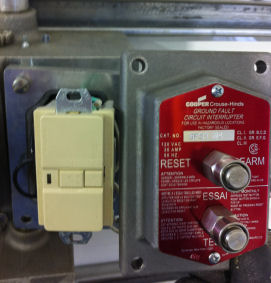What is a GFCI Circuit Breaker?
Ground fault circuit interrupters (GFCI circuit breakers) are similar to standard circuit breakers. They are not like a fuse at all.

A fuse is designed to prevent electrical fires. If a live wire accidentally touches a neutral wire – this can happen if the insulation disintegrates, gets chewed through by a mouse or a nail is accidentally driven through a wire within the wall – a large amount of current will flow through the circuit heating up the wires like the coils in a toaster.
A fuse is designed to heat up faster than the wire, thereby burning out before the heat from the wire can start a fire.
A GFCI circuit works more subtly. Take a look at an average 120 volt wall outlet. You will see that there are two vertical slots with a round hole below them.
The slot on the left is a bit larger than the one on the right. The larger one is the neutral and the smaller one is live or hot. The round hole below is the ground.
All the electricity used by an AC appliance flows from the hot to neutral. A GFCI circuit monitors how much current is flowing from the hot to the neutral.
In case of any type imbalance, the circuit is tripped – just like a circuit breaker. It is designed to detect imbalances as small as 5 milliamps, and can react in a split second.
How a GFCI Can Save Your Life
Electricians are required to work in all types of weather. You may have to work in the rain, or other wet conditions with your power tools.
Electricity takes the quickest route to find a ground and water is an excellent conductor. Since the drill is wet and you are standing on the ground, the current will try to pass through you to reach the ground.
This scenario puts a twist on the regular hot to neutral flow. If the electricity does try to pass through you, it could be fatal.
This is where the GFCI circuit breaker kicks in. It will sense the current flowing differently than it should, and trips the circuit – cutting off the electricity before any damage can be done.
The average household circuit breaker is rated at 15 or 20 amps. However, it only takes about 1/100 of an amp (10 milliamps) to stop the human heart.
The GFCI cuts the power at 5 milliamps. This reduces the risk of a fatal electric shock, but it does not completely prevent the risk. An electrical surge strong enough to trip the GFCI circuit is still very painful.
A GFCI circuit is very helpful, but it cannot replace a properly ground circuit. Grounding is still the most important part of being safe around electricity.
Test Your GFCI Circuit Regularly
Like all the equipment you use, a GFCI circuit breaker can wear out, get damaged or break down. This doesn’t happen often, but it is still a good idea to test your GFCI regularly – about once a month.
The most common damage is caused by a powerful surge or lightning strike.
To test the GFCI circuit breaker:
- Start by pushing the “reset” button on the unit
- Plug in a simple device with an on/off switch that can be tested instantly, like a lamp or trouble light, and turn it on
- Pushing the test button should turn the light off
- Push the “reset” again and the light should come back on
If the light does not shut off when you push the “test” button, then the GFCI is not working, or has not been installed correctly. If you are the one that installed the GFCI, then you need to assess the situation.
Most likely it is just a matter of the wiring being incorrectly connected, but it could be a faulty device.
Check the wiring. If everything is connected as it should be, then the unit itself is broken and you will have to replace it.
Types of GFCI Devices
There are some types of GFCI circuit breakers that you will be required to install in customer homes, as well as one you will need to use for your own personal safety.
Always look for the UL (Underwriters Laboratories) mark to ensure the device meets with electrical safety standards. UL is a global independent company that tests the safety and security of products in five key businesses:
- life and health
- product safety
- verification services
- environment
- knowledge services
GFCI Devices
- Wall receptacle. This type is the most commonly used. It fits right into a regular wall outlet, and protects against a fault in the ground whenever an electrical device is plugged into the outlet. You will usually install these in kitchens, bathrooms and laundry rooms, as well as outside where water and electricity might have a chance of coming together.
- GFCI circuit breaker. This type may be installed in the panel box to give additional protection to selected circuits. This type needs to be checked monthly. Don’t forget that the test will cut the power to everything on the circuit.
- Portable GFCI circuit breaker. This is the type you will want to have with you at all times. It is a self-contained unit with plugs in the back and slots in the front. You will use this for all of your power tools using electricity. In case of an electrical surge or other malfunction, this will save your life. A portable GFCI should be tested prior to every use.
Typical Locations for GFCI Protection
- bathroom receptacles
- kitchen receptacles near the sink
- laundry room receptacles or any other receptacles near a sink
- outdoor receptacles
- all receptacles in garages, crawlspaces or near pools and hot tubs
Since a GFCI is so extremely sensitive, there are some areas where you would never use one.
The normal cycling surges of certain appliances, such as refrigerators, freezers and sump pumps can cause the GFCI circuit to trip, which can be very inconvenient and may result in spoiled food, or flooding.





